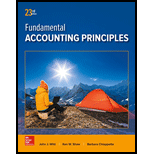
a
Introduction: Each company is required to adopt a method for valuing its inventory. There are several methods available for
To calculate: Costs assigned to units sold.
b
Introduction: Each company is required to adopt a method for valuing its inventory. There are several methods available for valuation of its inventory by a business. Some of them are FIFO, LIFO, Weighted Average and Specific Identification method. Each of these methods has its own pros and cons which are required to be considered while deciding the method to be adopted. The method adopted while solving is problem is FIFO.
To calculate: Costs assigned to ending inventory.
c
Introduction: Each company is required to adopt a method for valuing its inventory. There are several methods available for valuation of its inventory by a business. Some of them are FIFO, LIFO, Weighted Average and Specific Identification method. Each of these methods has its own pros and cons which are required to be considered while deciding the method to be adopted. The method adopted while solving is problem is FIFO.
To state: How likely will this method reflect actual flow of goods
d.
Introduction: Each company is required to adopt a method for valuing its inventory. There are several methods available for valuation of its inventory by a business. Some of them are FIFO, LIFO, Weighted Average and Specific Identification method. Each of these methods has its own pros and cons which are required to be considered while deciding the method to be adopted. The method adopted while solving is problem is FIFO.
To state: The impact of FIFO method versus other methods for net income and income taxes
e.
Introduction: Each company is required to adopt a method for valuing its inventory. There are several methods available for valuation of its inventory by a business. Some of them are FIFO, LIFO, Weighted Average and Specific Identification method. Each of these methods has its own pros and cons which are required to be considered while deciding the method to be adopted. The method adopted while solving is problem is FIFO.
To state: How closely does the ending inventory amount reflect replacement cost
Want to see the full answer?
Check out a sample textbook solution
Chapter 6 Solutions
Fundamental Accounting Principles
- Can you help me solve this general accounting question using the correct accounting procedures?arrow_forwardHorngren's Financial & Managerial Accounting: The Managerial Chapters, 8th Edition. E-M:9-14 Describing the balanced scorecard and identifying key performance indicators for each perspectiveConsider the following key performance indicators and classify each indicator according to the balanced scorecard perspective it addresses. Choose from the financial perspective, customer perspective, internal business perspective, and the learning and growth perspective. a.Number of customer complaintsb.Number of information system upgrades completedc.Residual incomed.New product development timee.Employee turnover ratef.Percentage of products with online help manualsg.Customer retentionh.Percentage of compensation based on performancei.Percentage of orders filled each weekj.Gross margin growthk.Number of new patentsl.Employee satisfaction ratingsm.Manufacturing cycle time (average length of production process)n.Earnings growtho.Average machine setup timep.Number of new customersq.Employee…arrow_forwardDo fast answer of this general accounting questionarrow_forward

 AccountingAccountingISBN:9781337272094Author:WARREN, Carl S., Reeve, James M., Duchac, Jonathan E.Publisher:Cengage Learning,
AccountingAccountingISBN:9781337272094Author:WARREN, Carl S., Reeve, James M., Duchac, Jonathan E.Publisher:Cengage Learning, Accounting Information SystemsAccountingISBN:9781337619202Author:Hall, James A.Publisher:Cengage Learning,
Accounting Information SystemsAccountingISBN:9781337619202Author:Hall, James A.Publisher:Cengage Learning, Horngren's Cost Accounting: A Managerial Emphasis...AccountingISBN:9780134475585Author:Srikant M. Datar, Madhav V. RajanPublisher:PEARSON
Horngren's Cost Accounting: A Managerial Emphasis...AccountingISBN:9780134475585Author:Srikant M. Datar, Madhav V. RajanPublisher:PEARSON Intermediate AccountingAccountingISBN:9781259722660Author:J. David Spiceland, Mark W. Nelson, Wayne M ThomasPublisher:McGraw-Hill Education
Intermediate AccountingAccountingISBN:9781259722660Author:J. David Spiceland, Mark W. Nelson, Wayne M ThomasPublisher:McGraw-Hill Education Financial and Managerial AccountingAccountingISBN:9781259726705Author:John J Wild, Ken W. Shaw, Barbara Chiappetta Fundamental Accounting PrinciplesPublisher:McGraw-Hill Education
Financial and Managerial AccountingAccountingISBN:9781259726705Author:John J Wild, Ken W. Shaw, Barbara Chiappetta Fundamental Accounting PrinciplesPublisher:McGraw-Hill Education





